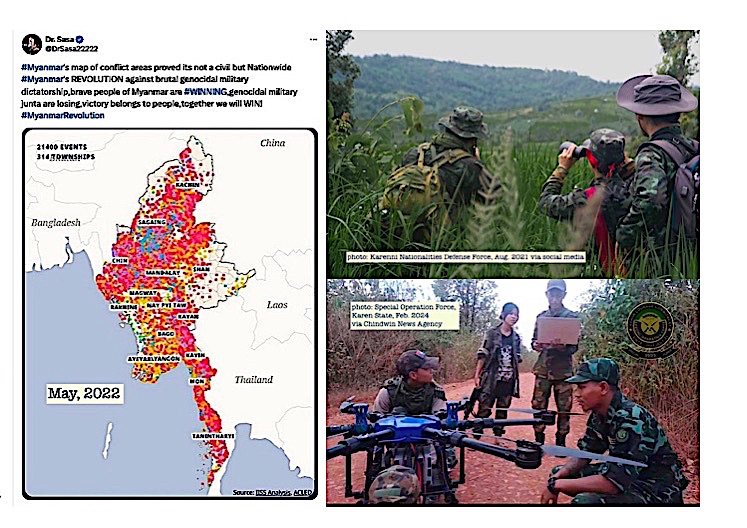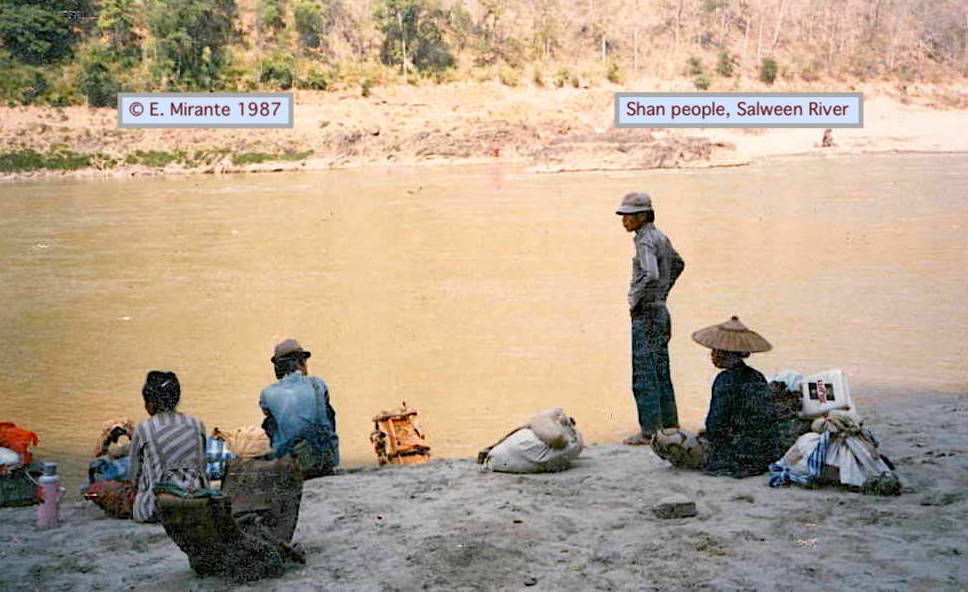1. This History Thread is about the military history of the Karen people of Burma (Myanmar.) Karen people have fought one of the longest-running resistance wars, spanning decades & have made recent gains vs Myanmar coup regime. #WhatsHappeningInMyanmar 







2. Karen ethnic people speak Tibeto-Burman languages. Their lands include highlands along Burma’s Thailand border & flat Irrawaddy Delta region. [This thread isn't about Karenni ethnic people, who are related to Karens but have their own homeland to the north.] Map: overview only 



3. During the ancient power struggles of lands that would become Burma, Karen people were often marginalized & sometimes enslaved by other ethnic groups. When Britain conquered lower Burma in mid-19th C., many Karens began converting to Christianity. 

4. Karen Christian converts got access to education, employment in British colonial administration (particularly forestry/timber.) Karens were recruited by British-colonized Burma as Karen Military Police & Karen Levies. Karens also served overseas in WW1 under British command. 

5. Some Buddhist Karens participated in prophecy-inspired uprisings, such as revolts against Burmese in 1840s & against British in 1850s. Such rebellions had charismatic leaders, grievances about taxation & often used invulnerability charms & rituals. 

6. Japanese & Burmese forces committed war crimes against Karen civilians in WW2 Burma. Karen soldiers were valued fighters for Allies vs Japanese occupation. Many with behind-lines outfits like Special Operations Executive. Karen nurses saved lives w. "Burma Surgeon" Seagrave. 



7. Karen National Union formed 1947. Burma independent ’48, 1st Army commander a Karen, Col. Smith Dun (replaced by Burmese Gen. Ne Win.) Attacks on Karens led to Karen National Defense Org. uprising which reached Rangoon '49. One of world's 1st airplane hijackings 1954 by KNDO. 

8. Karen National Union armed branches: KNDO & later Karen National Liberation Army (KNLA.) KNU founding leader Saw Ba U Gyi was captured by Burmese & killed in 1950, but his Four Principles have been the guideposts of the Karen revolution for over 75 years. 

9. From 1962, Gen. Ne Win's Burma dictatorship waged relentless war vs. Karen & other ethnic groups, with forced labor, rape, massacre, torture of civilians. KNU allied w. other armed ethnic forces. Gen. Bo Mya led KNU 1976-2004. Territory controlled mainly along Thai border. 







10. KNU avoided involvement in narcotics trade (which supported some ethnic armed groups) instead getting revenue from taxing timber, tin mines & cross-border trade in consumer goods. By 1980s, situation was static as trade routes were maintained. 

11. Over decades, KNU provided civil administration in its areas of control, including elections, schools & medical care. Sporadic fighting with Burma regime led to Internally Displaced People & refugees who fled to camps around Mae Sot, Thailand; some resettled overseas. 







12. In 1990s Myanmar SLORC junta boosted logging trade w. Thailand, decimating border forests. In ’94 a splinter group, Democratic Karen Buddhist Army, sided w. Myanmar regime & joined in '95 takeover of KNU GHQ Manerplaw (abandoned by KNLA), a severe economic setback for KNU. 



13. God’s Army, small Karen armed group whose leaders were twin 10-yr-old boys got major international press 1997. A non-Karen group + GA briefly took over Myanmar embassy in Thailand ’99. GA soldiers seized a Thai hospital in 2000. GA was defunct by 2001. theguardian.com/world/2006/jul…
14. Women have had significant roles in KNU/KNLA. Louisa Benson led KNLA 5th Brigade 1965-67. Maj. Mary Ohn served in KNLA 13th Bn. 970s-80s; was refugee camp administrator. Naw Zipporah Sein was KNU Gen. Sec. 2008-12 & VP '12-17. Naw Eh Moo, logistics officer for KNLA/Cobra. 







15. KNU entered a “Nationwide Ceasefire Agreement” w. Myanmar elected/military govt. in 2015, keeping its arms. There was a peace dividend for Karens of more civilian safety & civil society freedoms, but resource/land grabs occurred during the ceasefire. frontiermyanmar.net/en/knu-return-…
16. After Feb. 2025 Myanmar coup, KNU/KNLA protected protesters. Its ceasefire discarded, KNLA trained revolutionaries from many ethnic groups who took up arms vs coup regime, forming new units partly under KNLA command, incl. formidable Cobra Column. rfa.org/english/news/m…
17. Over the decades there hasn’t always been unity in Karen revolution. Assassination & factional splits occurred. Post-coup, Brig. Gen. Nerdah Bo Mya was under KNU investigation in 2021 for war crime by his troops; he broke away to form Kawthoolei Army. frontiermyanmar.net/en/we-must-not…
18. April 2024 KNLA seized a regime base near Myawaddy, an important trade town on the Myanmar/Thai border. But the regime-allied Border Guard Force of corrupt Karen “strongman” Saw Chit Thu assisted coup regime troops in keeping control of the town. aljazeera.com/news/2024/5/1/…
19. Saw Chit Thu, leader of Myanmar coup regime-allied Border Guard Force (aka Karen National Army) militia, profits enormously from the notorious Shwe Kokko gambling & cyber crime center in Myawaddy township. Human trafficking & forced cyber-scamming. irrawaddy.com/news/burma/tha…
20. Allied toward defeating the Myanmar coup regime, KNU cooperates w. other ethnic revolutionary groups & National Unity Govt. for command/coordination. Regime’s main tactic is relentless airstrikes, inevitably on civilian targets like schools, churches. myanmar-now.org/en/news/threat…
21. Myanmar regime airstrikes often target medical facilities. Naw Gay, Karen community healthcare worker & war zone medic, was severely injured in firebomb airstrike March 2025 while treating patients (2 other medics killed.) Donate for her medical care: earthmission-bloom.kindful.com/?campaign=1365…

22. Since Dec. 2024, KNU-led forces & allies have waged a swiftly effective major offensive vs. Myanmar coup regime positions across a range of districts of the Thailand-bordering Karen homeland Kawthoolei. Old KNU GHQ Manerplaw recaptured. irrawaddy.com/opinion/analys…
23/23. This History Thread is also available on my new blue sky account, same handle. Links to my previous Burma History Threads (incl. Chin, Kachin, Shan, Mon, Arakan military history) & reports are at: projectmaje.org

• • •
Missing some Tweet in this thread? You can try to
force a refresh




































